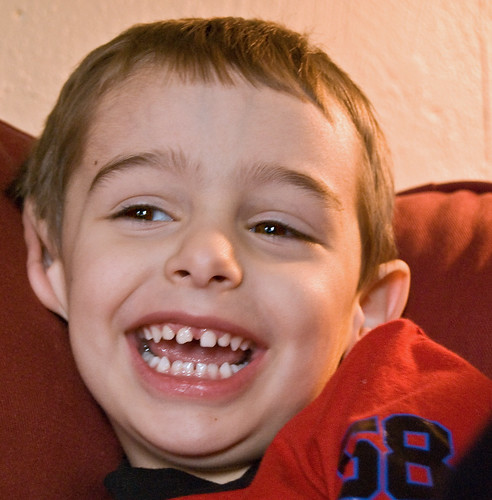I took the photos below last week when Hollis was home sick. I used only natural light. No flash. I played around with my ISO settings to see what the different "film" speeds would do to my picture clarity and noise.
Have I mentioned that I love my new camera?
Before playing with the ISO settings, my first question was, "How does ISO work? How does it affect shutter speed and all that jazz?" The answer, for those of us who know nothing about photography, is this:
ISO is a measure of a film's sensitivity to light. The less sensitive a film is to light, the more exposure time (and the slower the shutter speed) it requires. Digital works the same way. While a higher ISO may allow you to shoot in lower light conditions, the drawback is a photo with more noise. (That grainy texture you sometimes see in shots.) So a higher ISO number indicates a "faster" film. The faster the film, the faster the shutter speed will be if all other conditions (lighting, etc...) are kept the same.
The goal, for the highest quality photo, is usually to shoot at the slowest possible speed for the light conditions you have. Not always, but I think I need to learn the rules before I start deliberately breaking them.
ISO 200
Exposure: .017 of a second (slower shutter speed)
Aperture: f/5.6
ISO 400
Exposure: .077 of a second
Aperture: f/5.6
This photo was taken by a window in our living room on a cloudy day in the afternoon. Most of the other indoor photos I took at ISO400 didn't come out so hot because I wasn't using a tripod or flat surface to shoot all of them. The slower shutter speed needed at this ISO gives much more of an opportunity for motion blur in lower light.
ISO: 1000
Exposure (shutter speed): .033 of a second of exposure
Aperture: f/5.6
If I hadn't been playing around, I would probably never have tried using that speed unless I was taking photos at night or something. But with the right exposure, the photo really looks nice and crisp where I wanted it to be so (the eye). It works because the light was fairly low (although daylight), and the much faster shutter speed kept me from ending up with the motion blur that a slower shutter speed (like ISO 200) would cause without a tripod.
ISO 1100
Exposure:.033
Aperture: f/5.6
ISO 1250
Exposure: .033
Aperture: f/5.6
ISO 1250
Exposure: .033
Aperture: f/5.6
ISO 1400
Exposure: .033
Aperture: f/5.6
ISO 1600
Exposure: .04
Aperture: f/5.6
This one is a bit blurry, but I only shot a few at 1600 that weren't impossibly blurry or very noisy.
So now I can see how ISO affects the necessary exposure time for a shot. I must admit that my favorite photo was the one taken at ISO 1000 of Hollis's eye. That was certainly unexpected, but I'm sure I have many future surprises in store for me as I learn.
Monday, January 14, 2008
Sick Day and a "Speedy" Recovery
Posted by
Lawyer Mama
at
5:26 AM
![]()
Labels: ISO, natural light photography, Nikon D40x, Polaroid Moments
Subscribe to:
Post Comments (Atom)



4 comments:
I don't know anything about ISO but I do know that you're a great photographer
Sorry about the sick day - but a very nice tutorial on ISO! It is nice to see the distinct differences.
Thank you!
You have just helped me make my choice in cameras. I was trying to choose between the canon and Nikon d40x. You take wonderful pictures, but it's easy when you have beautiful subjects to photograph.
how wonderful. i still don't understand all that stuff! really great pics.
Post a Comment